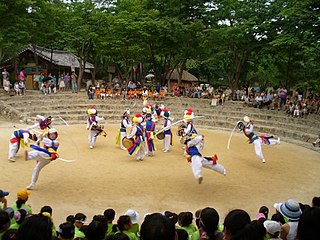Related Research Articles
Hammering Man is a series of monumental kinetic sculptures by Jonathan Borofsky. The two-dimensional painted steel sculptures were designed at different scales, were painted black, and depict a man with a motorized arm and hammer movement to symbolize workers throughout the world. They were structurally engineered by Leslie E. Robertson Associates (LERA).

Korean Folk Village (Korean: 한국민속촌) is a living museum type of tourist attraction in the city of Yongin, a satellite city in the Seoul Metropolitan Area in the province of Gyeonggi in South Korea. It was first opened on October 3, 1974. Korean Folk Village is a popular tourist destination for both Koreans and foreigners, located near South Korea's largest amusement park, Everland.

Gwanghwamun is the main and largest gate of Gyeongbok Palace, in Jongno District, Seoul, South Korea. It is located at a three-way intersection at the northern end of Sejongno. As a landmark and symbol of Seoul's long history as the capital city during the Joseon period, the gate has gone through multiple periods of destruction and disrepair. The most recent large-scale restoration work on the gate was finished and it was opened to the public on August 15, 2010.

Artsonje Center is a private art museum in Seoul, Korea, located in Samcheong-dong, a neighborhood adjacent to known for its numerous art galleries, cafes, restaurants and boutiques. Founded in 1998, the museum introduces current and experimental contemporary art to the art world and public with its international exhibitions and educational programs.
The Chunghyeon Museum is a museum in Gwangmyeong, Gyeonggi-do, South Korea.
Gahoe Museum (Korean: 가회박물관) is a private museum in Gahoe-dong, Jongno District, Seoul. Established in 2002, its collection includes over 1,500 items, including 750 amulets, 250 items of folk paintings, approximately 150 classical books, and 250 other odd items. The museum is located on a street of traditional Hanok houses and gardens. The main exhibition hall retains traditional Joseon era architectural features.
The Han Sang Soo Embroidery Museum is an art museum specializing in Korean embroidery located in Gahoe-dong, Jongno-gu, central of Seoul, South Korea. It was established by Han Sang Soo, who holds a title as a jasujang, a profession recognized as an Important Intangible Cultural Property by the Cultural Heritage Administration of South Korea.
Horim Museum is a museum in Seoul, South Korea.
The Korea Racing Authority Equine Museum is a horse museum in Gwacheon, South Korea. Established on September 13, 1988, to complement Equestrian at the 1988 Summer Olympics in Seoul, it has over 50,000 visitors annually in a variety of audiences, ranging from the elderly to children. It has roughly 1,500 exhibits in 123 square meters of showroom space. In 2008, a special exhibition was held running over 100 years of horse racing, and in 2009 hosted modern artwork, including painting, sculpture, ceramics and photographs related to horses.

The Leeum, Samsung Museum of Art is a museum in Hannam-dong, Yongsan District, Seoul, South Korea. It is run by the Samsung Foundation of Culture. It is considered one of South Korea's top three private art museums.

The Seoul National University Museum of Art (SNUMoA) is a museum in Seoul National University.
The Savina Museum is a private contemporary art museum of South Korea, located in Anguk-dong, Jongno-gu, Seoul.

Tteok Museum is a museum located in Waryong-dong, Jongno-gu, Seoul, South Korea. Founded by Yoon Sookja, the chief director of the Institute of Traditional Korean Food (한국전통음식연구소), it opened in December, 2002. The museum specializes in Korean cutlery with approximately 2,000 old Korean kitchen utensils from ancient maetdol to early 20th century kitchenwares on display and exhibits 50 of Korea's nearly 200 types of tteok.

The Seoul Museum of History (Korean: 서울역사박물관) is a history museum located at Sinmunno 1-ga, Jongno District, Seoul, South Korea.

The Whanki Museum is a private art museum in Jongno-gu, in central Seoul, South Korea. It was established by the Whanki Foundation mainly to exhibit and commemorate the art of Whanki Kim, one of Korea's foremost abstract painters. The museum is located in Buam-dong, close to Seongbuk-dong, Seongbuk-gu, where Whanki Kim and his wife spent many years. The atmosphere and natural environment of the two places have much in common. The museum building was designed by architect Kyu-seung Woo. Construction began in 1990, and the museum opened in November, 1992.

The World Jewellery Museum is a museum in Seoul, South Korea.

The National Palace Museum of Korea (Korean: 국립고궁박물관) is a national museum of South Korea located in Gyeongbokgung Palace, Seoul.

The Seoul Museum of Art (Korean: 서울시립미술관) is an art museum operated by Seoul City Council and located in central of Seoul, South Korea.

The International Friendship Exhibition is a large museum complex located at Myohyangsan, North Pyongan Province, North Korea. It is a collection of halls that house gifts presented to former leaders Kim Il Sung and Kim Jong Il from various foreign dignitaries. The protocol of gift-giving is well established in Korean culture.

The Songgyungwan was the highest educational institution established in Korea during the Koryo and Choson dynasties. It opened in 992. The institution consists of the Taesong Temple, Myongnyun Hall and 20 other buildings, including one of the largest wooden buildings to still exist in the DPRK.
References
- ↑ "《목인박물관 - 목석원》 종로구 창의문로 5길 46-1". Brunch Story (in Korean). 2023-06-09. Retrieved 2024-11-15.